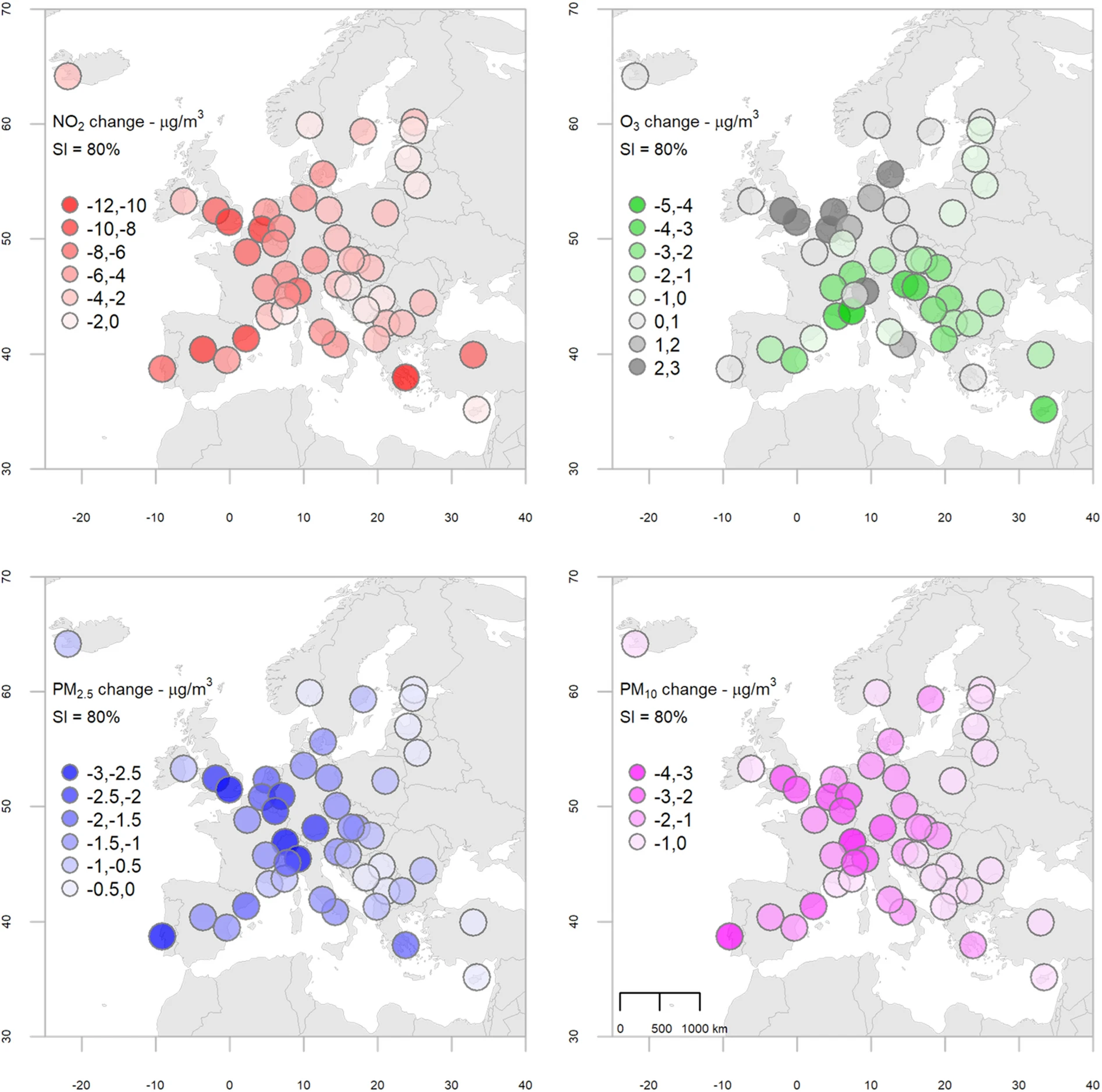

Strict COVID-19 lockdown policies such as workplace closures in European cities reduced levels of air pollution and the number of associated deaths, according to new estimates published in Nature’s Scientific Reports.
The research, which was funded by the European Centre for Medium-Range Weather Forecasts (ECMWF) on behalf of the Copernicus Atmosphere Monitoring Service (CAMS), was led by a team of statistical health and earth observation satellite modellers based at the London School of Hygiene & Tropical Medicine (LSHTM), with colleagues from CAMS.
The study compared government policies from 47 European cities from February to July 2020 and estimated the changes in pollution levels and related number of deaths avoided during the first wave of COVID-19 pandemic.
Government measures for COVID-19 such as school and workplace closure, cancelling public events, and stay-at-home requirements had the strongest effect on reducing NO2 levels. This is linked to the reduction in road transport and local mobility which is known to be a contributor to NO2 air pollution. Spanish, French and Italian cities had the largest decrease in NO2 of between 50% and 60% during the period.
Although strong decreases in NO2 were observed, levels of fine particulate matter PM2.5 and PM10 were reduced more modestly since they are also produced by natural sources (wildfires and dust), and other emission sources like residential activities, that were slightly increased during lockdown.
Antonio Gasparrini, Professor of Biostatistics and Epidemiology at LSHTM and senior author of the study, said: “The lockdown during the first wave of the COVID-19 pandemic created immense health and social costs, however, it has offered unique conditions to investigate potential effects of strict policies to reduce pollution levels in urban areas. This ’natural experiment’ has given us a glimpse of how air quality can be improved by drastic public health measures that would be difficult to implement in normal times. The information can be important to design effective policies to tackle the problem of pollution in our cities.


CAMS provided the surface-level data for this research using an ensemble of regional air quality models. This allowed the team to compare the concentrations of the main air pollutants with two emissions scenarios, one corresponding to business-as-usual conditions and the other corresponding to a detailed estimate of emissions resulting from the actual governmental measures taken during the first lockdown, varying for each country, each day and for each of the main activity sectors (road traffic, industry etc.).
Based on the estimates for NO2, there were 485.5 (confidence interval of 590.9; 377.6) excess deaths avoided associated with the exposure change (lockdown – business-as-usual difference), compared to 2,572.9 (confidence interval of 2,042.3; 3,070.9) excess deaths estimated under a business-as-usual scenario.
Across all pollutants, a total of more than 800 deaths were avoided with improved air quality resulting from the governmental measures taken to limit the spread of the SARS-Cov-2 virus. Paris, London, Barcelona, and Milan were among the top six cities with the highest number of avoided deaths.
Although all cities experienced a slight increase in air pollution levels after the strong decline in March and April 2020, levels remained below business-as-usual scenario estimates throughout the period studied. Restrictions on internal and international travel showed a minor impact on the local pollution levels.
Rochelle Schneider, Honorary Assistant Professor in Geospatial Data Science at LSHTM, Visiting Scientist at ECMWF, and first author of the study said: “Connecting expertise rapidly after and during the COVID-19 pandemic began has allowed us to estimate the health benefits from specific government measures. This, and other similar studies, can help drive the message that we definitely need to improve urban air quality for human health, and for the environment.”
“Government policies decided during the spring and early summer of 2020 gave us a unique opportunity to study a “real-life” scenario with lower air pollution levels. This paper conveyed strong messages on the potential of replicable, scalable, and collaborative research conducted with complementary expertise and knowledge from public health and tropical medicine universities, Copernicus, and meteorological institutes.”
Vincent-Henri Peuch, Director of the Copernicus Atmosphere Monitoring Service (CAMS), said: “This research benefits from a unique dataset provided by CAMS, which allows to compare as realistically and accurately as possible European air quality as it was experienced as a result of the COVID-19 measures and what would have happened under normal conditions. This overcomes many limitations of other studies, which compared for instance different years or different periods. The CAMS multi-model ensemble that has been used to generate this dataset has capabilities that have no equivalent in the world.”
Vincent-Henri Peuch added: “The findings are extremely significant as they consolidate the quantitative evidence that the COVID-related government measures had a direct effect on air pollution levels areas across Europe, particularly for NO2. Beyond the analysis of the mortality during the first months of the pandemic, this study could help shape future policy as the public health benefits of reducing pollution in our cities and the effectiveness of certain measures are clear to see”.

